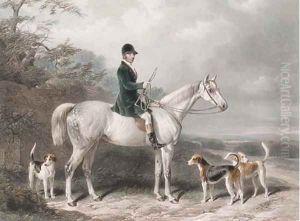William And Henry Barraud Paintings
William Barraud and Henry Barraud were two British brothers known for their remarkable talent in painting, particularly in the genres of animal painting and portraiture. William, the older of the two, was born in 1810, and Henry followed in 1824. Their careers in art, though overlapping, highlight a unique collaboration between siblings in the Victorian art world.
William initially established himself as a painter of animals, especially horses and dogs, which were popular subjects in the 19th century among the British gentry and aristocracy. His attention to detail and ability to capture the character and essence of his subjects earned him a reputable standing. In 1830, at the age of 20, William's talents were recognized, and he began exhibiting his work at the Royal Academy, a prestigious venue that signified recognition and respect in the art community.
Henry, on the other hand, initially embarked on a career in law but soon followed in his brother's artistic footsteps, drawn by his passion for painting. By the mid-1840s, Henry had joined William in his artistic endeavors, and together, they produced a series of paintings that are celebrated for their detailed depiction of horses and dogs, as well as sporting and country scenes. Their collaboration was not just limited to painting animals; they also produced landscapes and historical scenes, showcasing their versatility as artists.
The brothers' works were well-received, and they exhibited not only at the Royal Academy but also at the British Institution and the Society of British Artists, venues that were instrumental in their career development. Their paintings are characterized by their detailed realism, vibrant colors, and the dynamic portrayal of their subjects, capturing moments of action and the beauty of the English countryside. This made their work popular among collectors and the nobility, who sought their skills for portraits of prized animals and estate commissions.
Despite their success, the brothers' careers were relatively short-lived. William passed away in 1850 at the age of 40, leaving a legacy of animal painting that would influence future generations. Henry continued to paint and exhibit, maintaining the reputation of the Barraud name in the British art world until his death in 1878. Over the course of his career, Henry expanded his subject matter to include more religious and genre scenes, though he never strayed far from the animal subjects that had brought him and his brother fame.
The Barraud brothers left behind a body of work that continues to be appreciated for its contribution to Victorian art and animal portraiture. Their paintings can be found in various public and private collections, serving as a testament to their skill and the enduring appeal of their artistic vision.
